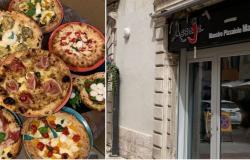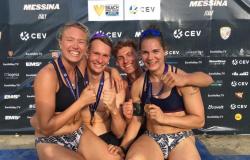SI returned, in the perfect light of a June afternoon, to the Ionian coast of Calabria. I passed by Badolato, Sansostene, Sant’Andrea Apostolo dello Ionio, Isca in the gulf of Squillace, Roseto Capo Spulico.

I called Gerardo Frustaci, who was mayor of Sant’Andrea, remembering the days many years ago in which I found, in the glory of her Calabrian choice, Anna Gastel, who is no longer here. She had left the great Milan behind to take refuge here, to have the skies and sea of this landscape in her heart, to find them again in paradise. It was very melancholy to return to these places and think of never being able to see her there again.
In the course of life, things happen that you couldn’t have thought of. And the melancholy increases when, having arrived in Reggio, a group of cheerful friends from the Alfonso Frangipane Institute, full of ceramics and wonderful fabrics produced in the tradition of that art school, pushes me towards the Palace of Culture to see the foundation of the San Paolo Museuma heterogeneous collection of ancient paintings, sculptures, art objects, icons, silver, chasubles and copes, feverishly collected by a priest, “sacerdos et civis”, Francesco Gangemi, to save them from markets and flea markets which humiliated their predominantly destination religious.
To open the small museum to me is called Pasquale Catanoso who kindly arrives. He was the magnificent rector of the University of Reggio Calabria. He is attentive, kind, initially I don’t recognize him, but he says words to me that recall an ancient confidence, if not a friendship. He has my phone number, and he asks me, with fervent expectation, for information on some paintings while he hands me a small album of photographs to bear witness to past occasions and intimacy.
Everything becomes clear: I had already seen those works on an unforgotten day, and in a different place, many years before. I had been taken to see Don Gangemi’s legendary and extravagant collection in the rooms of his crowded home adjacent to the church of San Paolo alla Rotonda. I remember a white gate to protect the beloved and varied heritage; and I remember, on the threshold, the thoughtful and apprehensive priest, ready to accompany us from painting to painting, from showcase to showcase.
The Alfonso Frangipane Art Museum in Reggio Calabria (courtesy Alfonso Frangipane Art Museum).
It is already very old, and austere and severe, in the precious document that Catanoso gave me, and which I initially look at distractedly. It is the photographic account of that visit, perhaps 25 years ago, in the last millennium. I see a young me and a very young girl dressed in white, almost a child. As I review the paintings I wonder who she is; then I focus more on the photographs, and it’s a shock to my heart when, among the others accompanying me, I recognize my mother and father, curious and concentrated but also a little lost among the many objects.
And I identify the Calabrian friends who accompanied me, in particular Franco Romeo di Ardore of whom, perhaps in those days, I would have become an honorary citizen, a passionate and apprehensive friend. And I see Peter Glidewell, a lifelong friend, present on many occasions and on many trips and, with him, Ferruccio Barbera, animator of the cult activities of Orlando’s Palermo and Fabio Granata’s Region. We are all young, carefree, shirtless and curious in front of the shop windows with chalices and liturgical clothes. We are our lost youth.
I struggle to watch Nino and Rina without being moved, my father, more composed, thoughtful and calm, my mother, impatient impatient, and also bored. I am always agitated, curious, impetuous. Nostalgia and regret are very strong. And above all, today, I am impressed by the childish appearance, the natural elegance but also the detachment, the distance, the imperturbability of the girl who is, herself, Sabrina, known for very little and caught up in a vortex from which she seems to want to escapewhile I try to convince her of the curiosity and passion of this priest, already over ninety years old, who lived for his saints and his Madonnas, trying to protect them from adventurers and unlikely collectors, and offering refuge to many testimonies of his faith, even modest, even insignificant, and of rather devotional than artistic interest.
And we, on that summer day at the end of the nineties, stir among the icons and vestments that Don Francesco lovingly collected. Now I find them in another order, but live the life he gave them. And meanwhile I see myself young and impatient in another time to escape from myself; and regret those days, and find in those objects a part of my lost youth.
iO Donna © ALL RIGHTS RESERVED






